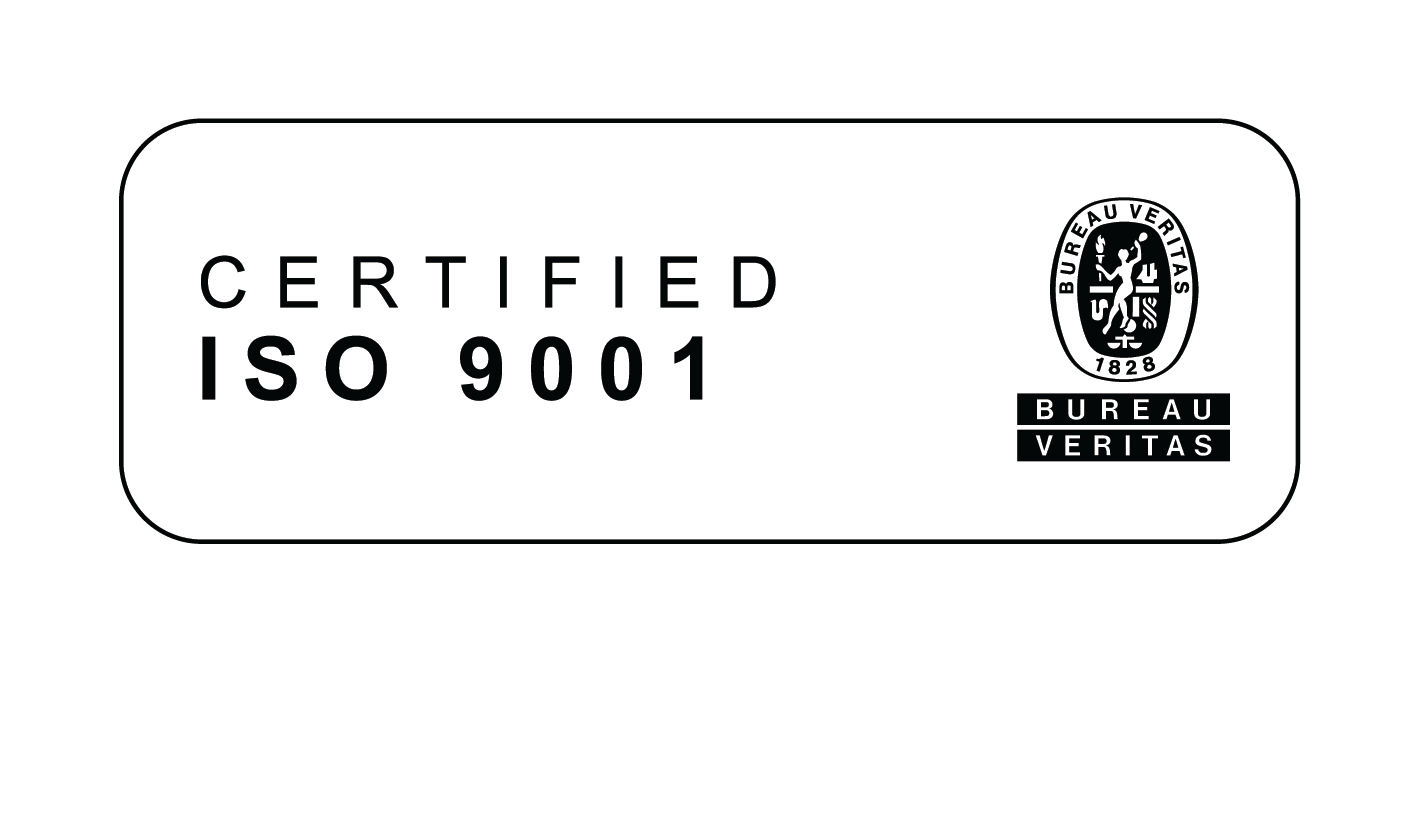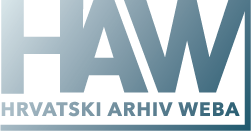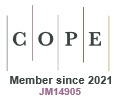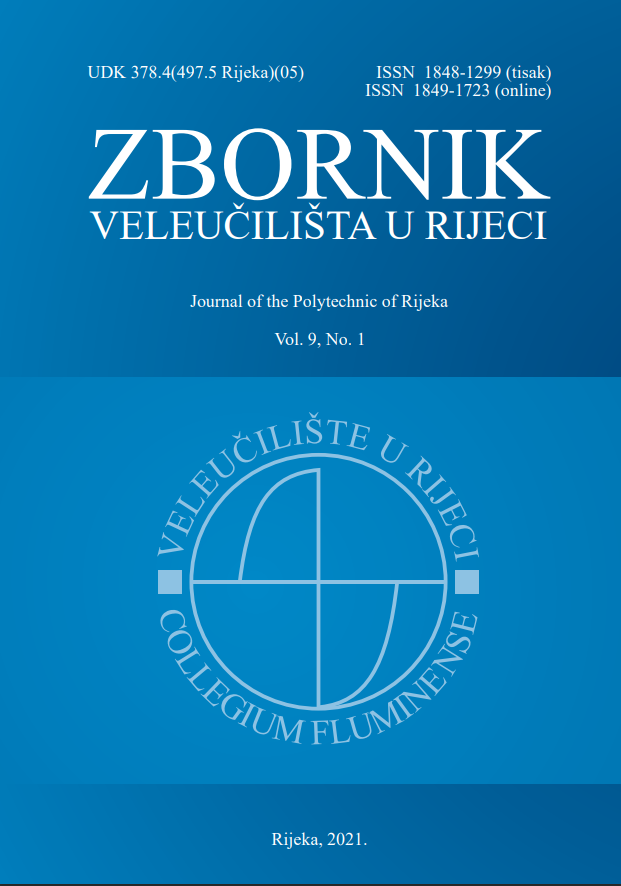Guidelines for Authors
Submitted manuscripts should be written in Croatian or British English using the Microsoft Word template. The author must ensure that it is complete, grammatically correct and without spelling or typographical errors. The authors are responsible for language editing.
All submissions need to be fully formatted in accordance with Guidelines for Authors. Manuscripts without proper formatting will be returned to the author(s).
When submitting your manuscript, please create a fully anonymized document containing the complete article.
The first page of the article should contain: the title of the article, abstract and key words in the language of the article (on the first page of the article submitted the authors are not mentioned). At the end of the article the same information is given:
- in Croatian (if the article is in English) and
- in English, if the original language of the article is other than English.
The main body of the text should begin with an introduction and contain sections, footnotes, tables, graphs, diagrams, references in the text, a conclusion and a bibliography.
We kindly ask our authors to follow COPE's international standards for responsible research publication available via the COPE website.
Text Editing
The text of the article should be written in Microsoft Word Windows program (95 or later versions). The manuscript should not exceed 7000 words (including abstracts, keywords, footnotes, tables, references, captions and appendices), and the font used should be Arial, font size 11 single-spaced, justified, written from the beginning to the end of the line (without indenting the first line of a paragraph), all margins at 2.5 cm. The length of the paper can exceed the above-mentioned limit only if the Editor-in-Chief consents. If it is necessary to highlight a specific word or a sentence italics should be used, never bold. Paragraphs should be double-spaced.
Footnotes should be used only for additional explanations of the text. They are not used to refer to literature used. They are put at the bottom of the page and numbered consecutively in Arabic numerals starting with the number 1.
Section headings (from Introduction to Conclusion) should be short and clear and numbered using single Arabic numerals. Section headings can have subsection headings which must be marked with double or maximum triple-digit numbers (e.g. 1; 1.1; 2.; 2.1; 2.1.1, etc.), but not more than that.
Tables, graphs and diagrams should have a number and a caption (written above the table, graph or diagram) as well as the source of information (written in a short form at the bottom; if it has been taken from another source – surname of the author (year); e.g. Source: Driankov et al. (1996)). They should be numbered consecutively in Arabic numerals (graphs should be numbered separately from diagrams).
Important note: If a table, graph or diagram contains some specific signs and is written in a special program, it should be submitted as a separate file with precise indications and marked insertion point in the text.
The article should comply with all the editing requirements listed in these guidelines.
Text Organization and Style
Authors should apply scientific methodology in presenting the contents of their papers complying with the standards of scientific publications.
This implies the following:
(1) Title and organization of the content of the paper:
The title is the most important abstract of the work which must contain the content and the objective of the paper. It should be clear, concise and informative (font size 14).
The content is divided into sections as follows:
• Abstract – below the title
• Key words
• Introduction
• Methodology / method / model / conception of the analysis – in the second section
• Empirical data (documented background) and analysis – in the third section
• Results and discussion – are presented in the fourth section
• Conclusion – at the end
(2) The content of particular sections of the material presented:
Abstract – it describes in short the content of the article, it contains a general overview of the topic in 150-250 words single-spaced, font size 10, italic, and should include:
• Purpose / objective of the research
• Methodology / method / model / conception of the analysis
• Findings / main results of the research (or the analysis)
• Originality of the research / contribution.
The abstract should not be written in paragraphs.
Key words – should reflect the essence of the article's content, usually, there are three to five words (font size 10, italic).
Introduction – is focused on defining the problem and subject matter of the research with reference to the latest literature, i.e. research results (this part can also be indicated in a separate section i.e. in the second section as Literature review); towards the end of the introduction working hypotheses should be formulated which will be discussed later on at the beginning of the conclusion; this part should end indicating the organization of the text.
Methodology / method / model / conception - is usually presented in the second section; the method / model / conception of the analysis should clearly be stated because of possible re-testing of the research results by interested researchers (this is one of the fundamental principles of scientific methodology).
Empirical data and analysis – contain documentation background and the results of the analysis.
Results and discussion – explain results, particularly their significance, meaning and messages.
Conclusion – it should be kept in mind that this part does not represent a summary! Conclusions are the author's original opinion (evaluation) on results obtained and they contain information on the starting hypothesis (whether it has been confirmed or not), main results of the research/analysis, referring to limitations and problems of the research as well as guidelines for future research.
(3) References – list only titles (sources) referred to in the text! Font size 9 is to be used, first line hanging.
Abstract in a language other than the original language of the article. After the text of the article written in Croatian, and a bibliography, an abstract in English should follow (up to 250 words). Together with the abstract in English, the title and key words of the article should also be included (in the final version of the article accepted for publication basic information on the authors in English is also included). If the text of the article is in English, after the bibliography an abstract in Croatian should follow (including the title and key words). If none of the authors speaks Croatian, the Editorial Board will provide a translation of the article summary (including the title and key words) into Croatian.
TABLES should be included in the text. All the information given in tables is put in rows and columns separated by single thin lines. Each column heading for numerical data should include the unit of measurement applied to all data under the heading. Large numbers can be expressed in smaller units with appropriate column headings (in thousands, millions, etc.). Tables are numbered consecutively in Arabic numerals (e.g. Table 1., Table 2., etc.), and next to the number the source of data should also be stated.
GRAPHS AND DIAGRAMS should be included in the text. They need to have a number, a title and a source of information. They should be numbered in sequence with Arabic numerals (graphs separately from pictures). The sources of information are stated below the graphs i.e. pictures.
- Note: The results indicated in tables and graphs are not described and repeated in the text, but should be related in the text by means of reference marks.
REFERENCES AND CITATIONS. Journal of the Polytechnic of Rijeka follows Harvard referencing style. Cited parts of the text are included in the text of the article, not in the footnotes. They are put in brackets with the name of the author and the year of publication e.g. (Horvat, 2003), and in the case of a citation, the page is also indicated (Horvat, 2003, p. 150). The abbreviation p. refers to a single page, and pp. refers to a range of pages. Ibid. and similar words should not be used. Each note is indicated in the same way it has been indicated the first time. If there are two authors e.g.: (Horvat and Courty, 2004). If there are more than two authors, the first one should be indicated followed by ''et al.'', e.g. (Horvat et al., 2003). When referring to several sources in the same set of brackets, they should be separated by semicolons and written in order of publication date (Singh, 2011; Davidson, 2015; Harding, 2018). For Internet sources in the references included in the text, only the basic domain is indicated (http://www.veleri.hr). Each reference (full details) should be listed in the reference list at the end of the paper (after the Conclusion and Acknowledgements, if included).
List of references comprises all sources used and mentioned in the text. The title REFERENCES does not include the number of heading. References are not numbered and are listed in alphabetical order by first author's last name and in chronological order when there are more sources by the same author.
References for books, journals and other sources are cited according to the following examples:
- Books: surname, initials (year) Title. Place of publication: name of the publisher
Bahtijarević-Šiber, F. (1999) Management ljudskih potencijala. Zagreb: Golden marketing
If there are two or three authors, their surnames and initials (year) are put in order as they appear in the book Title, place of publication: name of the publisher
Peršić, M. and Janković, S. (2006) Menadžersko računovodstvo hotela. Zagreb: HZRIF
If there are more authors (four or more), the surname of the first author is put followed by et al.
Norton, M. B. et al. (1981) A People and a Nation – A History of the United States. Boston: Houghton Mifflin Company.
- Journal article: surname, initials (year) 'Title of the article', title of the journal in which it was published, volume (number), pages. DOI number
Bogdan, S. (2019) 'Macroeconomic Impact on Stock Returns in the Croatian Hospitality Industry', Zbornik Veleučilišta u Rijeci, 7(1), pp. 53-68. https://doi.org/10.31784/zvr.7.1.2
Črnjar, K., Čikeš, V. and Ferenčak, K. (2019) 'The Assessment of Time Management Skills in Chinese and Croatian Students', Zbornik Veleučilišta u Rijeci, 7(1), pp. 83-94. https://doi.org/10.31784/zvr.7.1.3
If there are more authors (four or more), the surname of the first author is put followed by et al.
Buonincontri, P. et al. (2007) 'Managing the experience co-creation process in tourism destinations: Empirical findings from Naples', Tourism Management, 62, pp. 264–277. https://doi.org/10.1016/j.tourman.2017.04.014
Multiple works by the same author published in the same year, besides the year the “a, b, c” letters are used after the year:
Quah, D. T. (1993a) 'Empirical Cross-section Dynamics in Economic Growth', European Economic Review, 37(2-3), pp. 426-434
Quah, D. T. (1993b) 'Galton’s Fallacy and Tests of the Convergence Hypothesis', Scandinavian Journal of Economics, 95(4), pp. 427-443
- Sources from the Internet: surname of the author/editor, name initials, (year), 'Title of the article', title of the journal, date of publication, volume (number), pages or online equivalent, URL (date of accession)
If Internet sources do not give the name of the author: URL (date of accession).
Pathak, O. et al. (2014) 'Wi-Fi Indoor Positioning System Based on RSSI Measurements from Wi-Fi Access Points – A Trilateration Approach', International Journal of Scientific & Engineering Research, April, 5(4), pp. 1234-1238, https://www.ijser.org/rsazmakresearchpaper/Wi-Fi-Indoor-Positioning-System-Based-on-RSSI-Measurements.pdf (Accessed: 23. 1. 2017)
- Books of collected writings: author of the chapter (year of publication) 'Title of the chapter'. In surname of the publisher/Editor or author of collected writings, Title of collected writings. Place of publication: publisher, page reference. DOI
Silobrčić, V. (2000) 'Znanstvena proizvodnost i kriteriji vrednovanja znanstvenika u Hrvatskoj'. In Sunko, D. (ur.) Znanost u Hrvatskoj na pragu trećeg tisućljeća. Zagreb: HAZU, pp. 25-29.
- Papers in Conference Proceedings: author (year of publication) 'Title of the article', In Title of the Conference Proceedings. Place and date of the conference. Place of publication: publisher, pages of the section referred to. DOI
Piekkola, H. (2015) 'Intangible Investment and Growth in Europe', in Conference Proceedings of Eleventh International Conference Challenges of Europe: Growth, Competitiveness and Inequality, Split-Hvar, 27-29 May. Split: Faculty of Economics in Split, University of Split, pp. 183-198.
- Theses and dissertations: surname of the author, initials (year). 'Title', doctoral dissertation, the institution publisher, repository permanent link
Whitehead, S. M. (1996). 'Public and private men: masculinities at work in education management', doctoral dissertation, Leeds Metropolitan University
- Official publications: title of the publication/organization/institution (year) Title. Place of publication: publisher
World Tourism Organization (2018) UNWTO Tourism Highlights, 2018 Edition. Madrid: UNWTO. https://doi.org/10.18111/978928441987
Please include DOIs in your references (as a link). You can retrieve DOI through the following link: Simple Text Query form (Crossref). Copy and paste a list of references into the search box and select “List all possible DOIs per reference”, then select Submit.
DOI is inserted by the author at the end of references in a form: https://doi.org/10.31784/zvr.7.1.3
Črnjar, K., Čikeš, V. and Ferenčak, K. (2019) 'The Assessment of Time Management Skills in Chinese and Croatian Students', Zbornik Veleučilišta u Rijeci, 7(1), pp. 83-94. https://doi.org/10.31784/zvr.7.1.3
Other Journal Contributions
Other contributions are submitted in the same way as articles. They are not reviewed, but are evaluated and grouped by the Editorial Board in the following types of contributions:
Books reviews. Critical reviews are written in a clear and concise manner evaluating the structure, style and scientific achievements of a particular book. It starts with the name of the author (of the book in question), followed by his academic title, institution affiliation, the title and subtitle (if there is one) of the work, year of publication, publisher, number of pages, type of edition, language, ISBN and email address for contact. The author of the review signs the text at the end. Together with the name of the reviewer, the institutional affiliation is given and a copy of the cover page is enclosed.
Doctoral Dissertations Reviews. In the title of the review, the author of the dissertation is stated, followed by some basic information on the author (academic title, institution affiliation), title and subtitle (if there is one) of the dissertation, as well as the names of the members of the PhD committee. Further on a date, year, institution and place of the dissertation defence are indicated. The critical review describes the structure, style, evaluating methodology and research results. Theoretical and practical contributions to a particular scientific field are analysed. The author of the review signs the text at the end. Together with the name of the reviewer, the affiliation is given.
Reviews of conferences and other scientific gatherings. They are written as critical reviews. In the title of the review the following is included: title of the conference, organizers, date and venue of the conference/meeting, official language of the conference, the name of the person for contact, followed by email, webpage and information on conference materials. The review provides a clear and concise survey of the main objectives of the conference, names of keynote speakers and discussions of the participants on scientific achievements, research results and suggestions for further research on key issues. The author of the review signs the text at the end. Together with the name of the reviewer, the affiliation is given.
Letters to the Editor. A special section is available for comments, opinions and suggestions by readers, authors and other contributors.
Journal AI policies
Use of artificial intelligence (AI) - assisted technologies (such as Large Language Models [LLMs], chatbots, or image creators) in the production of submitted manuscript should be reported in the acknowledgment section.
If AI was used for data collection, analysis, or figure generation, authors should describe this use in the methods section in sufficient detail to enable replication of the approach, including the tool used, version, and prompts where applicable.
Authors should carefully review and edit the result because AI can generate authoritative-sounding output that can be incorrect, incomplete, or biased. Authors should not list AI and AI-assisted technologies as an author or co-author, nor cite AI as an author. Authors should be able to assert that there is no plagiarism in their paper, including in text and images produced by the AI.
Journal of the Polytechnic of Rijeka does not accept manuscript that use chatbots as co-authors. The reason for this is that LLMs do not satisfy our authorship criteria as they cannot bear responsibility for the accuracy, integrity, and originality of the content they generate.
Journal of the Polytechnic of Rijeka does not accept manuscripts that use chatbots as sources. The reason for this is that content generated by LLMs is not reproducible or traceable and can accidentally contain third-party material without identifying it as such.
- Journal of the Polytechnic of Rijeka does accept manuscripts that use chatbots as tools supporting research and writing processes (scaffolding). Acceptable purposes include research design, the formulation of RQa, proofreading, feedback on structure and style, general brainstorming, translations, data analyses, data visualization, and coding. Authors who use generative technologies in this manner need to acknowledge this at relevant locations in their manuscripts, in the following manner:
- For general scaffolding such as brainstorming, feedback on structure and style, research design, or proofreading, please add an acknowledgement at the end of your manuscript that contains information about the type of language model or other tool you employed as well as when and how you used it.
- For translations, please add a footnote to the part translated that contains information on the type of language model (or other machine translator) you employed, the prompt(s) you used, the date, and the original version of the text.
- Using LLMs for data analysis and coding purposes constitutes a significant methodological intervention. In such cases, please add a part to the methods section of your manuscript where you explain how you proceeded including the type of language model you employed, the prompt(s) you used (excluding the material to be coded or analyzed), the date, and a link to the dataset.
- When using chatbots for data analysis: please keep in mind that most generative LLMs that are freely available do not adhere to accepted standards for the handling of personal or sensitive data. Make sure you only use models that have been approved by your research institution or other reliable bodies.
- Before using LLMs or other generative technologies, please consider the ecological and human costs connected to these applications.
Journal of the Polytechnic of Rijeka does not use LLMs or other generative technologies for assessing incoming manuscripts. However, we check for possible plagiarism using the turnitin cross-reference tool.
The following statement must be added as an acknowledge before the list of references when using generative AI and AI-assisted technologies in scientific writing:
In preparing this paper, the author(s) used [NAME OF TOOL / SERVICE] for [REASON]. Following the use of this tool/service, the author(s) have reviewed and edited the content as necessary and take full responsibility for the content of the published article.
Copyright and OA Policy
The manuscript is submitted with the completed Application form which includes a signed Copyright Statement, the consent to submit the paper to the reviewing procedure, and Statement - consent for personal data collection, processing and sharing.
Authors guarantee that their paper represents an original contribution and that its publication will not infringe any existing copyright. Authors are fully responsible for the content of the submitted manuscript and they will incur all costs if an unauthorized use of copyrighted material is found.
In order to detect and avoid plagiarism, each manuscript is checked using Crossref Similarity Check (iThenticate).
By accepting contributions for publication, the publisher becomes the copyright holder.
The Journal of the Polytechnic of Rijeka supports an open-access policy, which enables unrestricted access to published papers in order to contribute to easier knowledge exchange.
By signing the Application form (Copyright Statement) the author gives consent to publish the article according to the rules of a CC BY-NC licence.
Important notes
Authors are responsible for ensuring that their manuscripts are accurately typed before final submission. They must ensure that it is complete, grammatically correct and without spelling or typographical errors. The authors are responsible for language editing. Therefore, they must submit a proofread final version of the positively evaluated paper in order to be accepted for publishing, together with the signed proofreading confirmation by professional proofreaders.
A test print will be sent to authors before the final publication to proofread, which must be returned promptly. At this stage, only misprints will be corrected.
Editorial Board disclaims responsibility for language and printing errors.
We expect honesty, originality and fairness from authors, as well as objectivity, confidentiality and fairness from editors and reviewers. Authors, editors, editorial board members and reviewers are obliged to adhere to ethical standards and Journal policy.
The Journal of the Polytechnic of Rijeka does not charge article submission, processing or publication fees (non-APC model).
Manuscript Submission
Papers are submitted via email zbornik@veleri.hr together with a completed Application form.
Deadline: 1st December
FORMS:
UDK: 378.4(497.5 Rijeka)(05) https://doi.org/10.31784/zvr
ISSN 1848-1299 (Print) ISSN 1849-1723 (Online)
The usage of full-text of the articles can be used exclusively for personal, research-related or educational purposes, with regard to the authors' and publishers' rights.












